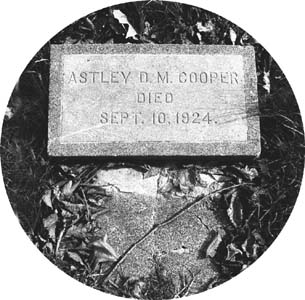![[Metroactive Features]](/features/gifs/feat468.gif)
[ Features Index | San Jose | Metroactive Central | Archives ]
 Photograph by E. Carlson Notes From the Underbelly In Search of Saloon Nudes
"Cattle and horses ran loose about the streets and there were no sidewalks." --Grandma Bascomb STANDING IN OAK HILL CEMETERY, next to Anna "Grandma" Bascomb's brand new grave marker, I couldn't help but think of poor old A.D.M. Cooper, whose bones lay moldering beneath an unkempt marker just down the road. It had taken Grandma 106 years to get a marker; A.D.M. need not hold his breath for an upgrade. Anna Bascomb (1816-1894) arrived in San Jose in 1849 at the molten moment of the gold rush. Her journal details gold fever prices that would make a San Jose rent-baron blush. After taking a wagon train from Kentucky to Sacramento, Anna and her family paid $132 boat fare to San Francisco, then another $150 to Alviso. A candle in Benicia cost $1.50. So take heart, valley renters--you aren't the first around these here parts to be gouged and groped. Grandma and family set up house in a rickety structure on San Fernando and Second Street--now a parking lot across from Gordon Biersch (a watering hole for beautiful people). The state legislature was in town and folks needed a place to stay. Anna started taking in boarders, and Flapjack Hall was born. In the mud of 1849. Grandma was a diminutive (98 pounds), cheerful sort of gal. Historian Ralph Rambo describes her thusly: "She was the most popular woman in San Jose with her merry, ceaseless chatter for everyone. She simply could not stop talking!" In fact, a judge once offered her $5 for her church if she would stop. She was saved by a lawyer who ponied up $5 to get her to talking again. And she has the distinction of being the first person in San Jose to own a piano--an event of no small import at the time. In 1883, 27-year-old Astley David Middleton Cooper arrived in San Jose, already internationally established as an artist of Western themes. A.D.M. had a lifelong obsession with Indians, buffalo and grand romantic landscapes. He saw the passing of Indian nations as an American tragedy. And he kowtowed to no one, not even Lady Jane Stanford, wife of robber baron Leland Stanford. Lady Jane had hired Coop to paint a collection of her jewels--an artistic record for posterity. Jane, buoyed by great pretension, demanded that he dress in formal attire and remain sober while painting. A man can only take so much. A.D.M. bolted, finished the painting in his studio--from memory--and displayed it in the window of a local tavern for San Jose's riffraff to enjoy. A.D.M. painted over a thousand paintings in his life, an output that did not deter him from enjoying the nightlife. Legend has it that he paid off many a bar tab with a painting--generally of a nude--that would hang behind the bar. Such a nude was a mark of distinction for any self-respecting saloon in the days of old. And still is. I know for a fact that Joel Wyrick, co-proprietor of Waves (and a man of infinite good taste), has been searching for an A.D.M. saloon nude for years, unsuccessfully. The closest he's come is an A.D.M. pastoral of a hound dog chasing a deer. Hardly a substitute for a naked lady. Clearly, the market for saloon nudes is untapped. After the dedication ceremony of Grandma's gravestone (an event that included Leonard McKay dressed up in historical garb talking to a mock Grandma Moses), Patricia Loomis conducted a short walking tour. We stopped for a moment at the marker of Clyde Arbuckle--the first "official" historian of San Jose. Clyde could tell you a thing or two about Grandma Bascomb and A.D.M. Clyde has a fine marker, as does Anna. But A.D.M. Cooper (1856-1924) is almost forgotten, lost in the green grass of Oak Hill Cemetery. [ San Jose | Metroactive Central | Archives ]
|
From the October 5-11, 2000 issue of Metro, Silicon Valley's Weekly Newspaper.
Copyright © 2000 Metro Publishing Inc. Metroactive is affiliated with the Boulevards Network.
For more information about the San Jose/Silicon Valley area, visit sanjose.com.